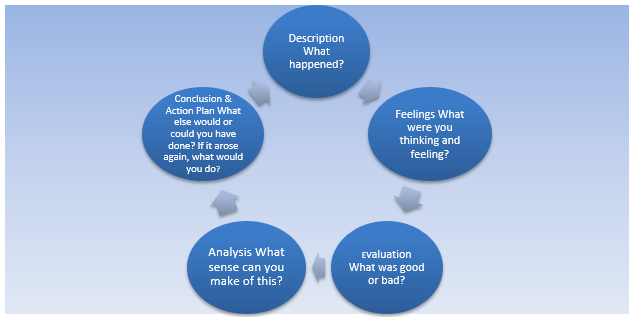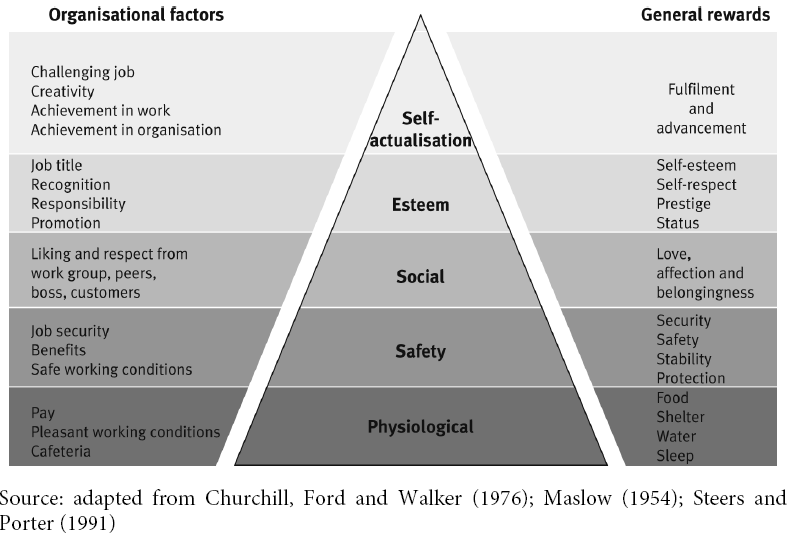Reward Reflection
In this reflection paper, the researcher used Gibbs’ Reflective Cycle to analyse how reward should be given to the junior employees and top executives.

Description of what happened
Reward is one of the most important factors that define employees’ motivation. According to Lindenau-Stockfisch (2011), employees tend to work best when they are motivated. I realised the power of motivation when I read through the class notes provided in the slides. I noticed that the rewards for the executives are different from that of junior employees. Top executives are given bonds and shares to motivate them, while junior employees are rewarded based on their performance (Yaping, 2003).
The Feelings
I have realised that when it comes to giving of rewards, care should be taken to understand who should be given what based on their managerial position in the firm (Toh & DeNisi, 2007). The top executives need rewards that can tie them to the firm. On the other hand, the junior employees mostly need monetary rewards or sometimes promotion at work. The feelings in this case are what define how the reward will be viewed. I noted that to the top executives, giving them part of the firm’s ownership makes them feel happy. On the other hand, junior employees are always happy when they are granted promotion or offered monetary benefits. This was a pleasant experience because it resulted into a win-win situation to all the parties involved.
Evaluation
I noted that reward plays an important role in motivating the employees. From the slides provided in class, it is clear to me that the only way of improving the output of workers is to give them a reward which is of value to them. Sometimes the need for a pay increase may arise. The employees may feel that the management is not doing enough to reward them appropriately. As I learnt from the notes provided, this may affect the way they handle their assignments.
Their total output, including what they produce during overtime, can be much less compared to what they produce before during the normal working hours if they feel that they are neglected. I noted with concern, that the issue of employee reward is something that a firm cannot take lightly. This to me is a demonstration that something must always be done to arrest the situation as soon as the employees start demanding for changes in their reward (Gowan & Ochoa, 2008). The management must consider the issue of the reward and adjust it as per the expectations of the employees.
Analysis
The analysis of the slides has made me appreciate the fact that reward is an important factor that defines employee’s motivation. As Kronberg (2011) says, money is not the only form of reward that a firm can give to its employees. In fact, Hofstede (2004) says that sometimes it may not be the most effective approach of motivating the workforce. However, there is a minimum allowable amount of reward that is commensurate to the output of the employees that the employer should not ignore (Grigoroudis & Siskos, 2010).
From the class notes provided, I noticed that, top management unit needs reward just as much as the junior employees. The only difference is the nature of reward they require as they work for the firm. From this analysis, I realised that a firm cannot ignore the relevance of employee rewards as a way of motivating employees (Hernon & Whitman, 2000). Maslow’s Theory of Needs may help the management to define appropriate reward.

Semi-skilled or unskilled employees who are just getting started in a firm will be interested in meeting physiological needs (Kusluvan, 2003). They need a pay that can meet the cost of their food, shelter, water, and basic health. Employees who have stayed in a firm for some time shall develop safety needs. These include security, safety, stability and protection at work (Kuballa, 2007). Skilled employees employed at junior management level will demand that social needs be met. The senior managers have esteem needs that should be met. As demonstrated in the class notes, these senior officers may need to be given shares as a way of motivating them. Self-actualisation may be achieved by the top manager (Clardy, 2007). Understanding the position of every employee makes it easy to determine the reward that is needed.
Conclusion and Action Plan
I have come to appreciate the importance of reward for all employees, from junior officers to top executives. Going forward, I strongly propose that the human resource unit should be conducting regular appraisal of the employees to determine how their rewards should be adjusted. I believe this will eliminate issues such as complaints or even rebellion at work.
Performance Reflection
Description of what happened
I took time to go through the notes provided in class about the performance of employees. The PowerPoint slides describe in details what it takes to make employees perform optimally. I noticed that it takes more than just telling them what to do or how to do it. Employees’ performance, including the performance of the top executives, is based on a number of factors. The quality of their output can be poor is the right approach is not used. As Novikova (2009) says, when the performance of an individual employee is affected in any way, then the overall performance of such an entity will be affected. This means that the management should be keen on addressing this issue.
The Feelings
I went through the slides to determine how the feelings of the employees are affected when there is a problem related to performance. I noted that every employee would prefer a situation where the performance of their firm and their individual performance is good. The slides and notes demonstrate that no one would be interested in being in an organisation that is underperforming. I learnt that performance of an individual firm has a direct impact on the feelings of its employees.
Evaluation
After critically evaluating the class materials that were provided to me, I noticed that the performance of employees can drop or improve based on a number of factors. The drop can be in terms of quantity of the output and quality of the products. This can be very destructive for a firm that is competing with others in the market. The situation can threaten the very existence of a firm and all the benefits that related stakeholders get from it.
Analysis
From the knowledge gained from these notes, I leant that the performance of the employees heavily depends on their level of motivation within an organisation. When an employee is not motivated, then it is almost impossible to expect good performance from them. I noted that when the management fails to take into consideration the plight of its employees, then it is almost impossible to get any good results from them (Oltra, Bonache & Brewster, 2013).
I also noted that it takes a serious effort for the managers to understand the needs of the employees. Sometimes employee may not communicate directly when addressing an issue that is affecting them. Instead, they act in a way that will alert the managers that something is wrong (Starling, 2011). It is the responsibility of the managers to identify what the problem is and how it can be addressed in time before the issue can be escalate to unmanageable scales.
Conclusion and Action Plan
From our class notes, I have learnt that performance of the employees is affected by the level of their motivation. Given the position of administrator, I can do a number of things that will help in motivating the employees. As a responsible manager, I will try to ensure that employees remain motivated in order to ensure that they perform optimally. I noted that the management should always respond to issues affecting their employees as soon as they arise (Gaurav, 2013). When it becomes apparent that employees are serious in their demands, the management should rush and find means of addressing the issue in a way that will protect the interest of all the stakeholders involved.
References
Clardy, A. (2007). Strategy, core competencies and human resource development. New York: Human Resource Development Internationa.
Gaurav, K. (2013). Drivers of employee satisfaction and attrition. New York: Grin Verlag.
Gowan, M. & Ochoa, C. (2008). Parent-Country National Selection for the Maquiladora Industry in Mexico: Results of a Pilot Study. Journal of Managerial Issues, 10(1), 103-118.
Grigoroudis, E., & Siskos, Y. (2010). Customer satisfaction evaluation: Methods for measuring and implementing service quality. New York: Springer.
Hernon, P., & Whitman, J. R. (2000). Delivering satisfaction and service quality: A customer-based approach for libraries. Chicago: American Library Association.
Hofstede, G. (2004). Exploring culture: exercises, stories, and synthetic cultures. New York: Yarmouth Intercultural Press.
Ivancevich, J., & Konopaske, R. (2013). Human Resource Management. New York: McGraw-Hill Irwin.
Kronberg, I. (2011). Employee Satisfaction on Cruise Ships. München: GRIN Verlag GmbH.
Kuballa, J. (2007). Employee satisfaction – A precondition for economical success of service companies. München: GRIN Verlag GmbH.
Kusluvan, S. (2003). Managing employee attitudes and behaviors in the tourism and hospitality industry. New York: Nova Science Publishers.
Lindenau-Stockfisch, V. (2011). Lean Management in Hospitals: Principles and Key Factors for Successful Implementation. Hamburg: Master Publishers.
McKeown, J. L. (2002). Retaining top employees. New York: McGraw-Hill.
Novikova, K. (2009). A study of customer satisfaction factors and employee satisfaction in the hospitality industry. New York: Cengage.
Oltra, V., Bonache, J. & Brewster, C. (2013). A New Framework for Understanding Inequalities Between Expatriates and Host Country Nationals. Journal of Business Ethics, 115(2), 291-310.
Starling, G. (2011). Managing the public sector. Belmont, CA: Wadsworth Cengage Learning.
Toh, M. & DeNisi, A. (2007). Host Country Nationals as Socializing Agents: A Social Identity Approach. Journal of Organizational Behavior, 28(3), 281-301.
Yaping, G. (2003). Subsidiary Staffing in Multinational Enterprises: Agency, Resources, and Performance. The Academy of Management Journal, 46(6), 728-739.